Abstract
This paper presents a new power system analysis tool named the Educational Simulator of Smart Grids (ESSG/SESG in French) for isolated, connected, and interconnected nanogrid and microgrid systems. The ESSG is a simulation tool launched through a Matlab application. It is based on theoretical concepts, enabling the modeling of various systems and the implementation of management and optimization techniques for different renewable energy system topologies. The simulations are performed using MATLAB software, where models are developed and simulated. Furthermore, a developed manager is offered to enhance the value of the ESSG application in terms of the software, incorporating the creation of a 3D environment. As a result, the observation and management interface will serve as a link between these two aspects. This work focuses on the optimal management and load balancing of nanogrids connected to Electric Vehicle (EV) stations, and all the results are integrated into the ESSG simulation tool. The overall graphical interface that was developed within the ESSG application was introduce in this paper. In addition, a microgrid system was integrated into the ESSG simulator to visualize and analyze the dynamic behavior of frequency and power transfer for an isolated and interconnected system with hybrid storage. This work was based on two topologies: isolated and interconnected.
1. Introduction
The smart grid is a modern electricity distribution system that uses digital technology to control and optimize the flow of electricity. It integrates renewable energy sources, energy storage, and advanced communication and automation technologies to improve efficiency, reliability, and sustainability in the power grid [1,2,3]. Furthermore, smart nanogrids are smaller-scale versions of smart grids, designed to operate independently or in conjunction with larger smart grid systems. They incorporate advanced technology to optimize energy use, storage, and distribution in localized areas such as buildings or homes. Smart nanogrids can help improve energy efficiency, reduce costs, and support the integration of renewable energy sources [4,5]. The interconnection between many nanogrids can be considered a microgrid that can be managed using the individual nanogrids. Also, microgrids are localized energy systems that can operate independently from the main power grid or in conjunction with it. They are smaller in scale than smart grids and are often used in specific areas such as neighborhoods, campuses, or military bases. Smart microgrids utilize advanced technology to efficiently manage energy generation, storage, and distribution, providing increased reliability, resilience, and flexibility in energy supply [6,7,8,9,10,11,12,13,14,15].
This paper purpose an efficient simulation tool named the Educational Simulator of Smart Grids (ESSG) shown in Figure 1. The ESSG is a simulation tool launched through a Matlab application. It is based on theoretical concepts, enabling the modeling of various systems and the implementation of management and optimization techniques for different renewable energy system topologies. The simulations are performed using MATLAB 2021 software, where models are developed and simulated. Furthermore, a developed manager is offered to enhance the value of the ESSG application in the software aspect, incorporating the creation of a 3D environment. As a result, the observation and management interface serves as a link between these two aspects. According to a literature survey on the latest developed and published works in the scope of educational software for power system analysis, a number of techniques and simulation software are developed by researchers to deal with power system problems. During the last few decades, various open-source MATLAB-based software applications have been developed for educational purpose, with the aim to help academics and researchers simulate and study diverse power system phenomena. In reference [16], Yang, J., and Anderson, M. D. proposed an educational software named PowerGraf for power systems analysis and design. In [17] Milano, F. proposed an open-source software-based MALAB application the called power system analysis toolbox (PSAT). In reference [18], Mallik, S. K. et al. proposed “An Educational Software for Enhancing Research in Power System State Estimation”. In reference [19], Milano, F. et al. developed an open-source power system virtual laboratory. In reference [20], Chabane, Y. et al. presented the PyPS tool, which is “An Open-Source Large Scale Power System Small Signal Analysis Software Package”. In reference [21], Ekinci, S. et al. presented the PowSysGUI tool, which is a new educational software package for power system stability studies using MATLAB/Simulink. In reference [22], Peng, C. Y. J et al. suggested the power analysis software for educational researchers.

Figure 1.
ESSG Logo.
Compared to existing simulation tools, the novelty of the ESSG software was to combine diverse simulation models that can be implemented to study various power system phenomena including isolated, connected and interconnected networks that involve new technologies such renewable energy sources. Also, the ESSG consists of designing an effective multi-stage power control and management strategy, combining diverse voltage and frequency actions (primary, secondary and tertiary) that can be supported and coordinated with the contribution of a hybrid energy storage system and optimization algorithms.
2. Nanogrids in ESSG
Our work focuses on the optimal management and load balancing of nanogrids connected to Electric Vehicle (EV) stations, and all the results are integrated into the ESSG simulation tool. The overall graphical interface that is developed within the ESSG application is introduced in this section. This main interface consists of a title and a logo, represented by a navigation button, as illustrated in Figure 2.
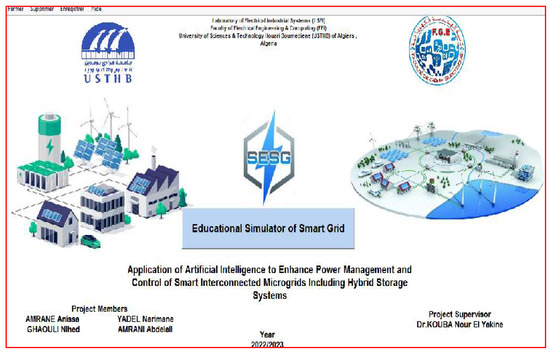
Figure 2.
ESSG main interface.
Moreover, by clicking on this navigation button, the user can access a sub-interface that allows them to choose between different topologies, such as nanogrid, microgrid, connection and website creation. However, our primary interest lies first in the nanogrid topology and the connection between nanogrid and microgrid and website creation which are accessible via another specific navigation button as shown in Figure 3.
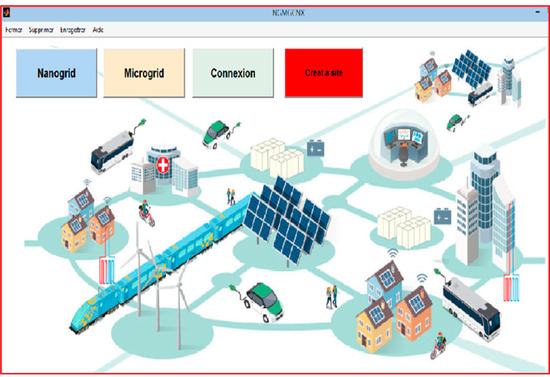
Figure 3.
ESSG navigation buttons.
The website creation button allows users to visualize implemented elements, observe management strategy results, and provide vital system status information to personnel managing electrical networks, as shown in Figure 4. The interface serves as a link between the simulation and real-time scenarios, enhancing the application’s value by simulating the actual behavior of renewable energy sources (RESs) in smart grids. Through the 3D interface, data from renewable sources like wind profiles and solar irradiance are displayed, offering valuable insights into renewable energy production status to managers. Overall, this feature optimizes renewable energy system management and performance.
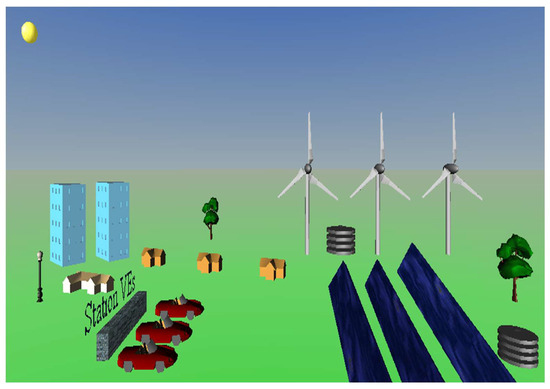
Figure 4.
Three-dimensional interface for observing the smart grid system.
Using this interface, users can configure and simulate various nanogrid configurations, as shown in Figure 5. By clicking on the “Nanogrid” pushbutton shown in Figure 3, users can access a sub-interface containing two topologies: Isolated Nanogrid (NG) and Interconnected Nanogrid (NG).
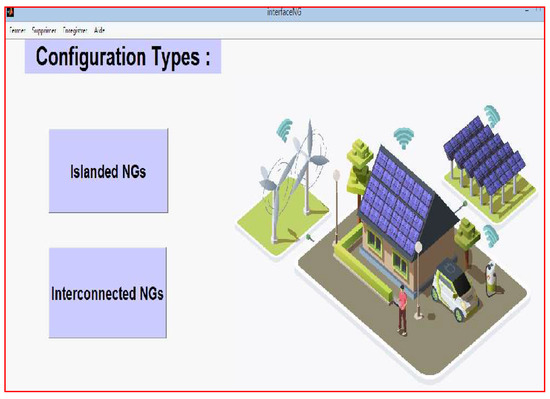
Figure 5.
Different configurations of nanogrids.
After selecting the desired topology, the user accesses specific interfaces, as illustrated in Figure 6 and Figure 7. The isolated NG interface allows us to program three programs corresponding to three different regions. After selecting the desired region, the user accesses the results’ interface to choose the desired outcome. By using the “Interconnected NG” button, users can explore the interconnection of NGs from different zones. There are two study cases available (decentralized and centralized), and the corresponding interfaces allow us to select the results for visualization and evaluate the performance of the nanogrids’ connection system.
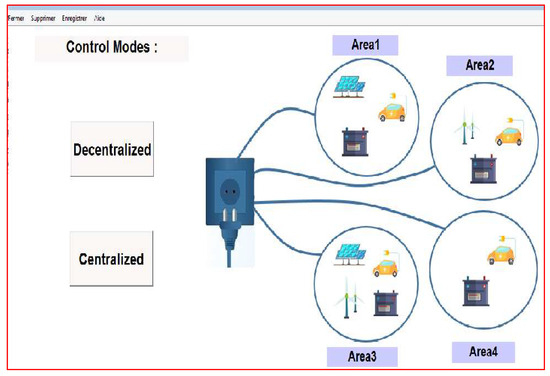
Figure 6.
Interface for nanogrid interconnection.
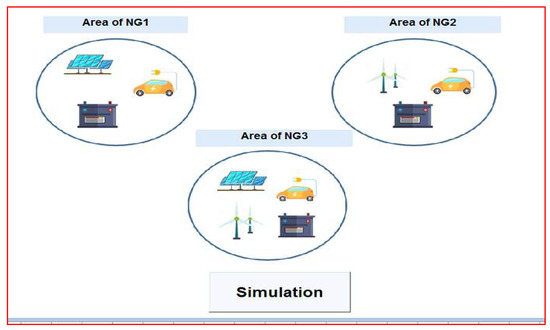
Figure 7.
The isolated NG interface.
By clicking on the “Connection” pushbutton, users will gain access to a sub-interface that allows for the exploration of two distinct topologies: NGMG/MGNG Connection and Grid Connection, as illustrated in Figure 8. Each of these interfaces provides the capability to configure, simulate, and analyze the performance and results associated with these different connection configurations.
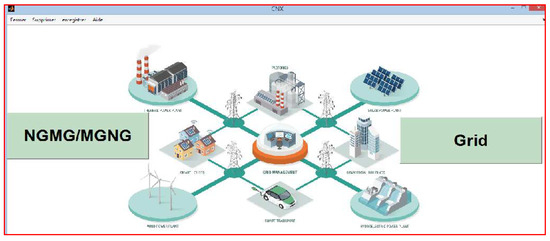
Figure 8.
The connection interface.
In this part, an example of the “Isolated Nanogrid” topology in a hybrid nanogrid system is presented. By selecting the appropriate checkboxes, including “load/charge,” users can visualize the load and production curve. Upon launching the simulation, the result is displayed in the “Edit Text” area, indicating that it represents a single nanogrid in a hybrid configuration. This approach allows us to evaluate the system’s performance and analyze specific results related to this configuration, as shown in Figure 9.
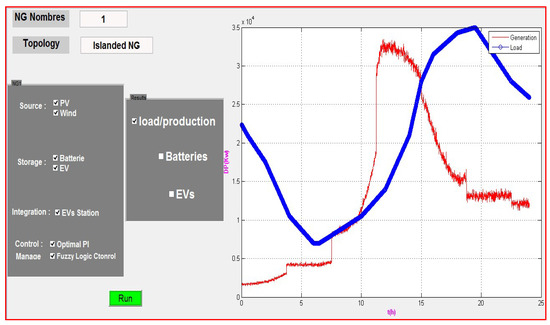
Figure 9.
Isolated hybrid nanogrid results.
3. Microgrids in ESSG
In this part, the MG (microgrid) system is integrated into the ESSG simulator to visualize and analyze the dynamic behavior of frequency and power transfer for an isolated and interconnected system with hybrid storage. By clicking on a MG as shown in Figure 3, another browser window appears, displaying the different topologies of this network (Figure 10).
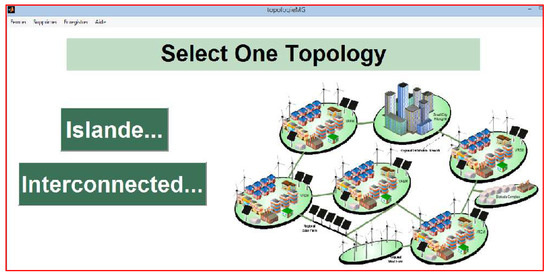
Figure 10.
Microgrid topologies.
Our study is based on two topologies, isolated and interconnected. By clicking on “Isolated”, an interface is displayed with a choice between “Optimization GOA” and “Without Optimization”, as shown in Figure 11, which pertains to how the microgrid will be simulated and studied. The “Without Optimization” option in our interface utilizes conventional methods such as PID (Propotional–Integral–Derivative) and Fuzzy-PID for simulating and studying and isolated microgrid.
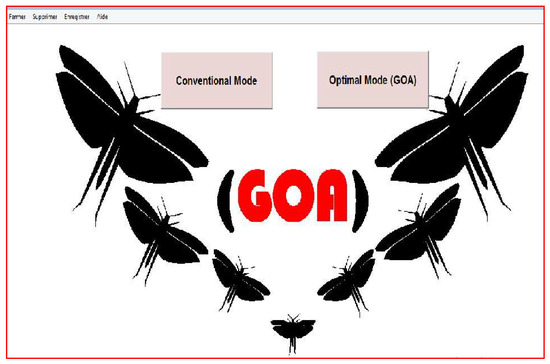
Figure 11.
With and without optimization.
When clicking on the “Without Optimization” button, a window displays three zones representing our three microgrids (Figure 12). Each one consists of a conventional energy source (diesel generator) and renewable energy sources, as well as a storage system and a load, depending on our selection, whether it is static dynamic or multi-loads. The “Run” button (Figure 13) enables the user to initiate their desired scenario simulation.
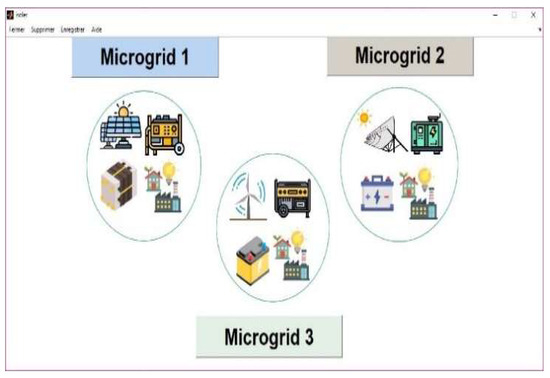
Figure 12.
Isolated microgrids.
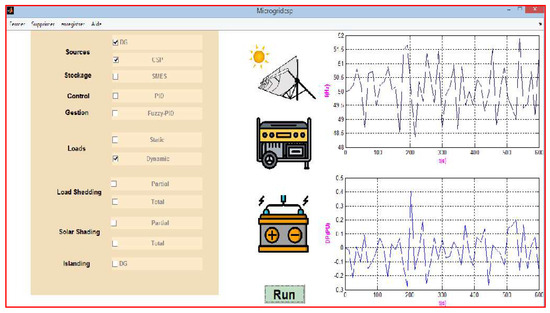
Figure 13.
Simulation browser of a microgrid.
When users click on the “With Optimization” button, the window appears as shown in Figure 14. The user selects the desired microgrid and the type of control to be used. A text bar below the Run button displays the name of the simulated scenario. On the right, two graphs are displayed representing the frequency profile and power transfer based on the selected scenario.
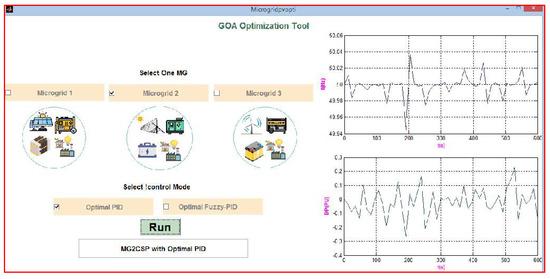
Figure 14.
Example of simulation for an optimal MG scenario.
When users click on the “With Optimization” button, the window appears as shown in Figure 15. The user selects the desired microgrid and the type of control to be used. A text bar below the Run button displays the name of the simulated scenario. On the right, two graphs are displayed representing the frequency profile and power transfer based on the selected scenario. Centralized and decentralized storage in microgrids refer to how energy is stored and distributed within the system.
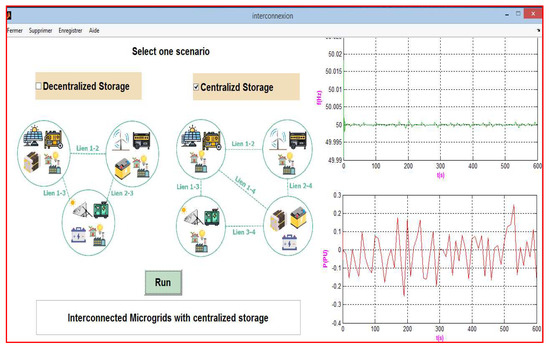
Figure 15.
Interconnected microgrids.
Decentralized storage refers to the presence of small energy storage units distributed at various points within the microgrids. These storage units are typically located near the renewable energy sources or loads. They allow for the storage of locally produced energy and release it when needed. On the other hand, centralized storage involves one or larger energy storage systems located in the fourth zone interconnected with the other three zones of microgrids.
4. Conclusions
This paper presented an efficient tool named the Educational Simulator of Smart Grids (ESSG) that was dedicated to the power system management and dynamic frequency control of isolated, connected, and interconnected nanogrid and microgrid systems. Basically, the ESSG was developed as an educational tool, with the aim to facilitate a simulation task for students. The ESSG includes three main simulators, which are as follows: (1) nanogrids (NGs), (2) microgrids (MGs), and (3) interconnected NG-MG.
Presently, our group works to enhance the ESSG by adding new simulation models:
- Hybrid energy storage system;
- HVDC transmission link;
- Offshore wind farm;
- Hybrid marine power generation units;
- Economic Dispatch Control (EDC);
- Optimal Under Frequency Load Shedding (OUFLS);
- Electrical Vehicle model with smart V2G strategy.
In future work, a novel version of the ESSG will be presented with a large list of nature-inspired optimization algorithms and various simulation models of distributed generation units and storage system devices, which will allow several studies to be performed.
Author Contributions
Conceptualization, N.E.Y.K., N.Y., A.A.A., A.A. and N.G.; methodology, N.E.Y.K.; software, N.E.Y.K., N.Y., A.A.A., A.A. and N.G.; validation, N.E.Y.K., N.Y., A.A.A., A.A. and N.G.; formal analysis, N.E.Y.K., N.Y., A.A.A., A.A. and N.G.; investigation, N.E.Y.K., N.Y., A.A.A., A.A. and N.G.; resources, N.E.Y.K.; data curation, N.E.Y.K., N.Y., A.A.A., A.A. and N.G.; writing—original draft preparation, N.E.Y.K., N.Y., A.A.A., A.A. and N.G.; writing—review and editing, N.E.Y.K., N.Y., A.A.A., A.A. and N.G.; visualization, N.E.Y.K., N.Y., A.A.A., A.A. and N.G.; supervision, N.E.Y.K.; project administration, N.E.Y.K.; funding acquisition, N.E.Y.K. All authors have read and agreed to the published version of the manuscript.
Funding
This research received no external funding.
Institutional Review Board Statement
Not applicable.
Informed Consent Statement
Not applicable.
Data Availability Statement
No new data were created.
Conflicts of Interest
The authors declare no conflicts of interest.
References
- Omitaomu, O.A.; Niu, H. Artificial intelligence techniques in smart grid: A survey. Smart Cities 2021, 4, 548–568. [Google Scholar] [CrossRef]
- Lamnatou, C.; Chemisana, D.; Cristofari, C. Smart grids and smart technologies in relation to photovoltaics, storage systems, buildings and the environment. Renew. Energy 2022, 185, 1376–1391. [Google Scholar] [CrossRef]
- Moreno Escobar, J.J.; Morales Matamoros, O.; Tejeida Padilla, R.; Lina Reyes, I.; Quintana Espinosa, H. A comprehensive review on smart grids: Challenges and opportunities. Sensors 2021, 21, 6978. [Google Scholar] [CrossRef] [PubMed]
- Jamal, S.; Tan, N.M.L.; Pasupuleti, J. A review of energy management and power management systems for microgrid and nanogrid applications. Sustainability 2021, 13, 10331. [Google Scholar] [CrossRef]
- Santoro, D.; Delmonte, N.; Simonazzi, M.; Toscani, A.; Rocchi, N.; Sozzi, G.; Cova, P.; Menozzi, R. Local power distribution—A review of nanogrid architectures, control strategies, and converters. Sustainability 2023, 15, 2759. [Google Scholar] [CrossRef]
- Yim, J.; You, S.; Blaabjerg, F.; Lee, Y.; Gui, Y.; Kim, W. Energy management systems for forecasted demand error compensation using hybrid energy storage system in nanogrid. Renew. Energy 2024, 221, 119744. [Google Scholar] [CrossRef]
- Mbungu, N.T.; Ismail, A.A.; AlShabi, M.; Bansal, R.C.; Elnady, A.; Hamid, A.K. Control and estimation techniques applied to smart microgrids: A review. Renew. Sustain. Energy Rev. 2023, 179, 113251. [Google Scholar] [CrossRef]
- Hasankhani, A.; Hakimi, S.M. Stochastic energy management of smart microgrid with intermittent renewable energy resources in electricity market. Energy 2021, 219, 119668. [Google Scholar] [CrossRef]
- El Yakine Kouba, N.E.Y.N.; Amrane, Y. Application Of Artificial Intelligence To Enhance Marine Microgrid Frequency Control Coordinated with Battery Energy Storage System and HVDC Transmission Link. Innov. Mach. Intell. (IMI) 2023, 3, 24–33. [Google Scholar] [CrossRef]
- Kouba, N.E.; Sadoudi, S. Islanded Microgrid Frequency Control in Presence of HVDC-Connected Marine Power Plant Coordinated with Optimal Fuzzy-PID and Hybrid Energy Storage Devices. In Proceedings of the 2023 IEEE Third International Conference on Signal, Control and Communication (SCC), Hammamet, Tunisia, 18–20 December 2023; pp. 1–6. [Google Scholar] [CrossRef]
- Lü, X.; Wu, Y.; Lian, J.; Zhang, Y.; Chen, C.; Wang, P.; Meng, L. Energy management of hybrid electric vehicles: A review of energy optimization of fuel cell hybrid power system based on genetic algorithm. Energy Convers. Manag. 2020, 205, 112474. [Google Scholar] [CrossRef]
- Rathor, S.K.; Saxena, D. Energy management system for smart grid: An overview and key issues. Int. J. Energy Res. 2020, 44, 4067–4109. [Google Scholar] [CrossRef]
- Qayyum, S.; Ullah, F.; Al-Turjman, F.; Mojtahedi, M. Managing smart cities through six sigma DMADICV method: A review-based conceptual framework. Sustain. Cities Soc. 2021, 72, 103022. [Google Scholar] [CrossRef]
- Singh, T.; Solanki, A.; Sharma, S.K.; Nayyar, A.; Paul, A. A decade review on smart cities: Paradigms, challenges and opportunities. IEEE Access 2022, 10, 68319–68364. [Google Scholar] [CrossRef]
- Aliero, M.S.; Qureshi, K.N.; Pasha, M.F.; Jeon, G. Smart Home Energy Management Systems in Internet of Things networks for green cities demands and services. Environ. Innov. 2021, 22, 101443. [Google Scholar] [CrossRef]
- Yang, J.; Anderson, M.D. PowerGraf: An educational software package for power systems analysis and design. IEEE Trans. Power Syst. 1998, 13, 1205–1210. [Google Scholar] [CrossRef]
- Milano, F. An open source power system analysis toolbox. IEEE Trans. Power Syst. 2005, 20, 1199–1206. [Google Scholar]
- Mallik, S.K.; Chakrabarti, S.; Singh, S.N. An Educational Software for Enhancing Research in Power System State Estimation. Electr. Power Compon. Syst. 2018, 46, 802–813. [Google Scholar] [CrossRef]
- Milano, F.; Vanfretti, L.; Morataya, J.C. An open source power system virtual laboratory: The PSAT case and experience. IEEE Trans. Educ. 2008, 51, 17–23. [Google Scholar] [CrossRef]
- Chabane, Y.; Hellal, A.; Ladjici, A. PyPS: An Open Source Large Scale Power System Small Signal Analysis Software Package. In Proceedings of the 2018 International Conference on Electrical Sciences and Technologies in Maghreb (CISTEM), Algiers, Algeria, 28–31 October 2018; pp. 1–6. [Google Scholar]
- Ekinci, S.; Demiroren, A.; Zeynelgil, H.L. PowSysGUI: A new educational software package for power system stability studies using MATLAB/Simulink. Int. J. Electr. Eng. Educ. 2017, 54, 283–298. [Google Scholar] [CrossRef]
- Peng CY, J.; Long, H.; Abaci, S. Power analysis software for educational researchers. J. Exp. Educ. 2012, 80, 113–136. [Google Scholar] [CrossRef]
Disclaimer/Publisher’s Note: The statements, opinions and data contained in all publications are solely those of the individual author(s) and contributor(s) and not of MDPI and/or the editor(s). MDPI and/or the editor(s) disclaim responsibility for any injury to people or property resulting from any ideas, methods, instructions or products referred to in the content. |
© 2024 by the authors. Licensee MDPI, Basel, Switzerland. This article is an open access article distributed under the terms and conditions of the Creative Commons Attribution (CC BY) license (https://creativecommons.org/licenses/by/4.0/).